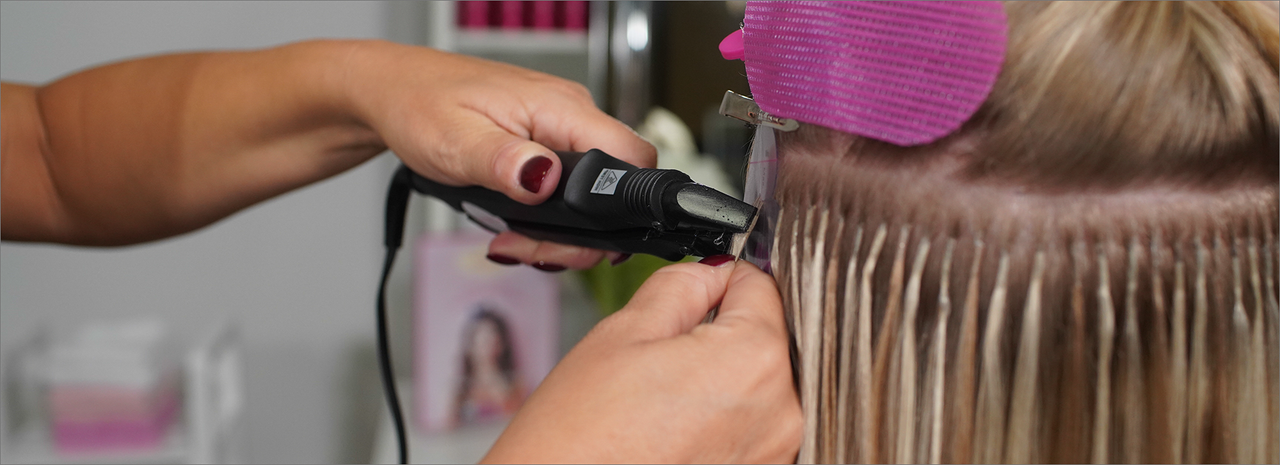As stylists, we know that hair comes in all colors, lengths, textures, and thicknesses. Most of us have experience working on straight strands, curls, thick manes, and thin tresses alike, for anything from a standard trim to a wild dye job. And we realize that, in general, anything that can be done to one hair type can be applied to another with little-to-no difficulty. Sure, the tactics that you use to get the job done may differ, but there’s nothing stopping you from employing the service itself, so long as the client has healthy hair to work with. Hair extensions, however, can be a bit different. Not only do we advise against installing on very short hair (with few exceptions), but we also warn against installing certain types or lengths of hair extensions on exceptionally fine hair. In that sense, it’s not exactly an equal playing field. However, most of us know that it is still possible to install hair extensions on fine hair, given a couple of hacks and extra tools. But do your clients know that?
The next time you’re in a situation where you need to explain the hair extension options available to your fine-haired client, be sure to offer up these little truth bombs:
Fine hair is not the same as thin hair.
This one can be a bit confusing to some clients, who may not distinguish between hair volume and individual hair thickness. Basically, it’s possible to have a lush, full head of hair made up of many fine hairs, or a thin spread of hair made up of a few thick hairs, because the number of hairs on your head is not directly aligned with the thickness of each individual hair. Thin hair, where there are few enough hairs on the head that you can essentially see through to the scalp, can be indicative of scalp problems, which should always be resolved prior to installing extensions. Fine hair is pretty normal, and it just means that your individual hairs are less thick than the average strand of hair. If your client needs additional information, feel free to show them this video.
Fine hair can be pretty strong, as long as you take care of it.
The average hair strand can hold about 100 grams, according to scientists at L’Oréal Research. That’s roughly the weight of a bar of soap, or a small apple (by some estimates). Fine hair, though weaker than the average strand, can still carry quite a bit of weight. We found a video that features a finer-than-average strand of hair that could handle 62 grams of pennies and tape all on its own. Think of what a full head of hair could carry, if only the scalp could support it! So long as the hair is well-hydrated and well-treated, it should be strong and elastic enough to handle most hair extensions like a champ.
If your scalp is healthy, there’s nothing to worry about.
Again, the scalp is usually the culprit behind fine-hair and thin-hair troubles. If your client feels discomfort when too much pressure is applied to the hair, they feel it in their scalp, not the hair itself. Problems with hair strength or elasticity can be spotted when there’s excessive hair breakage, and they can be treated with hair-boosting supplements, like biotin and fish oil pills. Also, problems with hair strength can be countered by selecting the appropriate extension method (more on this below). Scalp health, however, should always be verified prior to hair extension installation, because a modified method and/or supplements may not be enough to address the problem. A healthy scalp is free of build-up, unburdened by clogged pores or inflammation, and actively growing and shedding hair at a normal rate. If your client’s scalp is healthy, everything else should be perfectly manageable.
The Tape-In method was specifically designed for finer hair types.
In an effort to make our hair extensions accessible to everyone, we introduced a cutting-edge extension method that distributes the weight of the extension hair across a wider section of the client’s natural hair. This method, called the Tape-In method, effectively reduces the strain on individual hairs, making it the most comfortable and sought-after extension type in our arsenal. Tape-In hair extensions are a great option for anyone, but they’re an especially great fit for finer-haired clients who tend to favor the lighter hold.
For extra-fine hair, there’s always Single Sided Tape.
Here at Babe, we’re always looking for ways to improve upon our existing offerings. That’s why we took our Tape-In efforts a step further by introducing Single Sided Tape—a product that allows you to replace the second Tape-In weft needed in a Tape-In installation section with a single piece of tape. This little hack basically halves the weight of your typical Tape-In ensemble, guaranteeing a nearly weightless new look! Show your client what Single Sided Tape looks like in action! If this doesn’t convince them to bite the bullet, nothing will.
Have comments or questions for us? Feel free to leave them in the space below! We’ll get back to you with our response ASAP.

